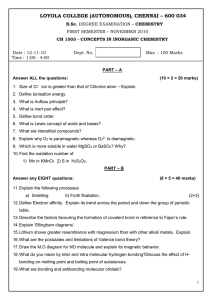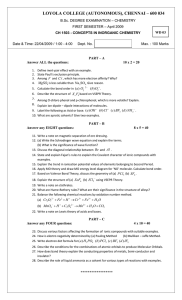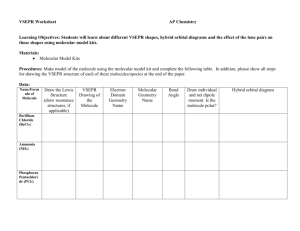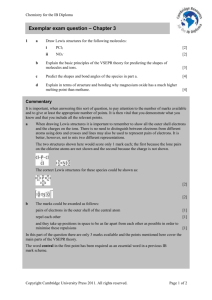CH 1503 - Loyola College
advertisement
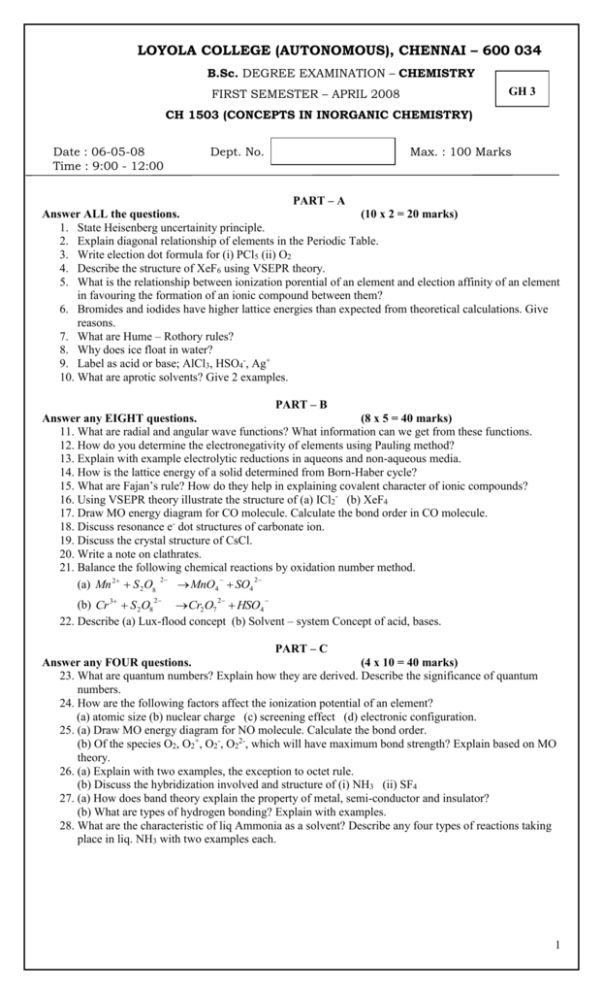
LOYOLA COLLEGE (AUTONOMOUS), CHENNAI – 600 034 B.Sc. DEGREE EXAMINATION – CHEMISTRY GH 3 FIRST SEMESTER – APRIL 2008 CH 1503 (CONCEPTS IN INORGANIC CHEMISTRY) Date : 06-05-08 Time : 9:00 - 12:00 Dept. No. Max. : 100 Marks PART – A Answer ALL the questions. (10 x 2 = 20 marks) 1. State Heisenberg uncertainity principle. 2. Explain diagonal relationship of elements in the Periodic Table. 3. Write election dot formula for (i) PCl5 (ii) O2 4. Describe the structure of XeF6 using VSEPR theory. 5. What is the relationship between ionization porential of an element and election affinity of an element in favouring the formation of an ionic compound between them? 6. Bromides and iodides have higher lattice energies than expected from theoretical calculations. Give reasons. 7. What are Hume – Rothory rules? 8. Why does ice float in water? 9. Label as acid or base; AlCl3, HSO4-, Ag+ 10. What are aprotic solvents? Give 2 examples. PART – B Answer any EIGHT questions. (8 x 5 = 40 marks) 11. What are radial and angular wave functions? What information can we get from these functions. 12. How do you determine the electronegativity of elements using Pauling method? 13. Explain with example electrolytic reductions in aqueons and non-aqueous media. 14. How is the lattice energy of a solid determined from Born-Haber cycle? 15. What are Fajan’s rule? How do they help in explaining covalent character of ionic compounds? 16. Using VSEPR theory illustrate the structure of (a) ICl2- (b) XeF4 17. Draw MO energy diagram for CO molecule. Calculate the bond order in CO molecule. 18. Discuss resonance e- dot structures of carbonate ion. 19. Discuss the crystal structure of CsCl. 20. Write a note on clathrates. 21. Balance the following chemical reactions by oxidation number method. 2 2 MnO4 SO4 (a) Mn 2 S 2 O8 2 2 (b) Cr 3 S 2 O8 Cr2 O7 HSO4 22. Describe (a) Lux-flood concept (b) Solvent – system Concept of acid, bases. PART – C Answer any FOUR questions. (4 x 10 = 40 marks) 23. What are quantum numbers? Explain how they are derived. Describe the significance of quantum numbers. 24. How are the following factors affect the ionization potential of an element? (a) atomic size (b) nuclear charge (c) screening effect (d) electronic configuration. 25. (a) Draw MO energy diagram for NO molecule. Calculate the bond order. (b) Of the species O2, O2+, O2-, O22-, which will have maximum bond strength? Explain based on MO theory. 26. (a) Explain with two examples, the exception to octet rule. (b) Discuss the hybridization involved and structure of (i) NH3 (ii) SF4 27. (a) How does band theory explain the property of metal, semi-conductor and insulator? (b) What are types of hydrogen bonding? Explain with examples. 28. What are the characteristic of liq Ammonia as a solvent? Describe any four types of reactions taking place in liq. NH3 with two examples each. 1

